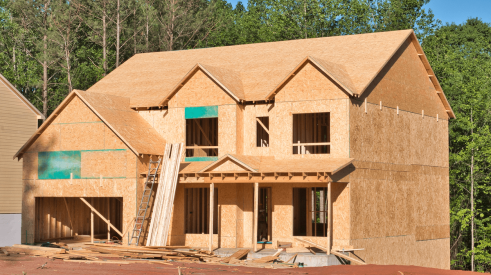If you limit yourself to the headlines, 2006 was a bad year for builders. New home sales lagged, construction costs soared and homes sat vacant for months.
But for builders who have adopted new building science technologies, the market is looking bright.
In the past year, the Partnership for Advancing Technology in Housing (PATH) has met many builders who have increased their business by using factory-built systems or manufactured components to improve the building envelope.
Here are Professional Builder and PATH's take on the top building technologies of 2006.
Today's factory building is a far cry from yesteryear's.
 |
As reported in "Streamline Your Business" in our August issue, manufacturing sections of the home in a controlled factory environment helps ensure product quality and consistency while it speeds the home-building process. The components can be built more quickly because factory workers can work in all weather, and on-site assembly goes swiftly because workers erect whole sections at once using the minimum tools.
Frank Dusick, owner of Mustang Builders in Eau Claire, Wis., started as a stick builder more than 40 years ago, but bad knees forced him to look for other options. In 1981, he switched to building modular homes.
The homes comprise individual modules that are delivered from the factory to the site, bolted to a foundation, and hooked up to services. Site-specific embellishments, such as window bays, porches and garages, make the home look like any other.
Beyond quality, the main advantage for Dusick is speed. It takes 10 to 12 weeks from the day a customer walks into Dusick's office to the day he turns over the keys. Dusick has increased his profit margin because the homes sell for the same price but cost 10 to 15 percent less to build. Dusick also enjoys less need for skilled labor, fewer home inspections and less expensive builder's insurance.
After years of traditional stick-building, Paul Truax, owner of Vermont Built in Chester, Vt., switched to panelized components to improve the quality of his framing.
As reported in our March issue, panelized systems take many forms, from structural components such as roof trusses to all-in-one panels that include framing, insulation and sheathing. These systems significantly speed wall and roof construction.
Because erecting the panels is easy, construction requires less skilled labor, and because they go up fast, workers — and materials — spend much less time exposed to the weather.
Introduced in our August issue, Fernando Pages-Ruiz, owner of Brighton Construction, has built his business on building quality homes at an affordable price.
Author of "Building an Affordable House," Pages-Ruiz continuously seeks technologies that achieve quality and affordability. He decided to try advanced framing techniques after reading about them in a PATH demonstration project.
Advanced framing uses engineering principles to reduce the need for lumber. The techniques also reduce the need for labor, cut costs and time and yield a more energy-efficient home. Although not all builders do advanced framing with factory-built components, Pages-Ruiz has a factor assemble the panels and ship them to his sites for quality control, affordability and speed.
 |
Discussed in our November issue, structural insulated panels (SIPs) result in more durable walls that go up quickly and require less skilled labor and less time on site.
SIPs are made from a thick layer of foam sandwiched between two pieces of oriented strand board, plywood or fiber-cement. The long-term energy savings for homeowners won over Scott Bergford, president of Scott Homes in Olympia, Wash.
Brian Bock of Mustang Construction in Naperville, Ill., builds with precast concrete wall and floor panels for commercial and residential projects. Strength and speed drew him to the technology.
Builders often use precast concrete, a concept we discussed in our January issue, for foundations. A typical panelized foundation can be erected in four to five hours without the need to place concrete on site. The result is a foundation that can be installed in any climate zone in one-sixth the time needed for a formed concrete wall.
Panels are installed quickly with the use of a crane and then immediately backfilled after waterproofing. Precast panel construction also generates less waste than conventionally framed homes.
Manufactured building components can be engineered to certain specifications, which speed and simplify the building process while improving durability and energy efficiency. Many of these products are more sustainable because they are manufactured from recycled materials.
In November, Professional Builder and PATH teamed up to discuss ICFs.
As discussed in "Strong, Silent Types," building with insulating concrete forms (ICFs) speeds construction time and still delivers a durable home, particularly important in high-wind areas. ICF buildings are also very energy efficient because the higherR-values lower air infiltration rates.
ICFs also provide a competitive edge. Just ask Ann Crocker and Ross Rains of Energy Smart Solutions in Flower Mound, Texas, who use ICFs to give them an edge over the competition.
"We have increased our market share by educating consumers who have an open mind about technological innovations," Crocker says.
In our October issue, we introduced Doug Edwards, who has been building with autoclaved aerated concrete (AAC) since 1999.
A precast, manufactured building block, AAC goes up as easily and is as strong as a standard concrete masonry unit structure, but much lighter, which can save construction time. AAC is also more energy-efficient.
Available in a variety of forms, from wall and roof panels to blocks and lintels, AAC can be sawed, drilled, nailed and milled, making it highly adaptable to a variety of architectural styles. And it can easily be engineered to meet structural load requirements.
While contractors often report some initial hiccups with new technology, they also report that having a little experience solves most problems. Most importantly, these technologies have given them a competitive edge.
| BENEFITS TO THE BUILDER | BENEFITS TO THE BUYER | ||||||
| Technology | Speeds Construction | Reduces Labor or Material Costs | Superior Marketing Appeal | Eases Code Compliance | Durability | Energy Efficiency | Comfort |
| Modular Homes | • | • | • | • | • | • | |
| Advanced Framing | • | • | • | • | |||
| Panelized Components | • | • | • | ||||
| ICFs and SIPs | • | • | • | • | • | • | |
| Precast Concrete | • | • | • | • | • | • | |
| Autoclaved Aerated Concrete | • | • | • | • | • |
| Author Information |
| Scott Shepherd writes about better building practices on behalf of the Partnership for Advancing Technology in Housing (PATH). PATH is administered by the U.S. Department of Housing and Urban Development. Learn more at www.pathnet.org. |
Advertisement
Related Stories
Single-Family Homes
What Does It Cost to Build a Single-Family Home?
A closer look at the itemized costs in each stage of construction for a single-family home
Builders
A Look at the Boom in Home Builder Stocks During 2023
In 2023, stocks for the 10 biggest U.S. home builders outperformed the S&P 500. What does that say about the housing market?
Financials
Housing Demand Could Rebound in 2024 as Mortgage Rates Ease
The Mortgage Bankers Association predicts lower mortgage rates could bring homebuyers back into the market in 2024






